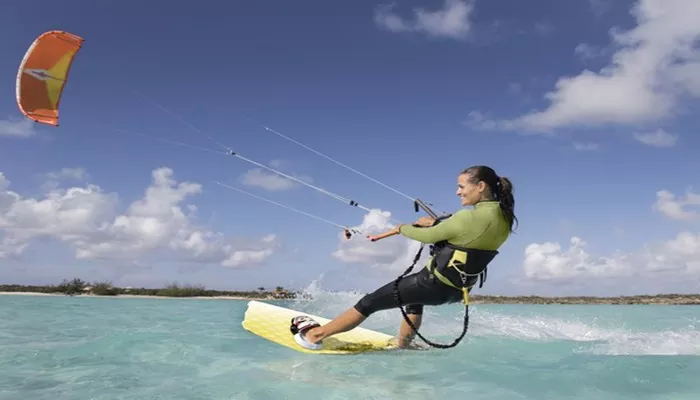Windsurfing is a thrilling water sport that relies heavily on wind conditions for an enjoyable and safe experience.
Understanding the ideal wind speed for different skill levels, board and sail sizes, and specific windsurfing disciplines is essential for maximizing performance and safety.
In this article, we will explore how much wind is needed for windsurfing, breaking it down for beginners, intermediates, and advanced riders while considering different equipment and environmental factors.
Understanding Wind Speed in Windsurfing
1. How Wind Speed Affects Windsurfing Performance
Wind speed plays a crucial role in determining the ease of handling the sail, stability on the board, and the overall experience. Too little wind can make movement difficult, while excessive wind speeds can be dangerous for those who are unprepared.
Wind speed is typically measured in knots (kt), miles per hour (mph), or meters per second (m/s). The Beaufort Wind Scale is often used to categorize wind speeds in relation to water conditions.
| Wind Speed (knots) | Wind Speed (mph) | Beaufort Scale | Windsurfing Suitability |
| 0-5 kt | 0-6 mph | 0-1 | Not enough for windsurfing |
| 6-10 kt | 7-12 mph | 2月3日 | Ideal for beginners |
| 11-15 kt | 13-17 mph | 3月4日 | Good for intermediates |
| 16-25 kt | 18-29 mph | 4月5日 | Advanced riders, freeride, and slalom |
| 26+ kt | 30+ mph | 6+ | Expert-level, wave sailing, and speed windsurfing |
Wind Speed Recommendations by Skill Level
1. Beginner Windsurfers
For beginners, it is best to start in light wind conditions between 6-12 knots (7-14 mph). At this level:
The sail is easy to control.
The board remains stable and balanced.
The risk of falling is minimal, making it ideal for learning basic maneuvers.
2. Intermediate Windsurfers
As windsurfers progress, they can handle stronger winds in the range of 12-18 knots (14-21 mph). At this stage:
Planing (gliding on the water) becomes possible.
More advanced techniques, such as harness use and foot strap control, come into play.
Sail sizes decrease as wind speed increases.
3. Advanced and Expert Windsurfers
Experienced windsurfers thrive in wind speeds of 18-30+ knots (21-35+ mph), depending on their discipline:
Freestyle windsurfers need moderate winds (15-25 knots) for tricks and jumps.
Wave windsurfers prefer stronger winds (20+ knots) to catch waves and perform aerial maneuvers.
Slalom and speed windsurfers can push limits with 25+ knot winds, reaching speeds over 40 knots.
Choosing the Right Equipment for Wind Conditions
1. Sail Size and Wind Speed
The size of the sail determines how much wind it captures and how easy it is to control. General sail size recommendations based on wind speed:
| Wind Speed (knots) | Sail Size (m2) |
| 6-10 kt | 6.0 – 7.5 |
| 11-15 kt | 5.0 – 6.5 |
| 16-20 kt | 4.5 – 5.5 |
| 21-25 kt | 4.0 – 4.7 |
| 26+ kt | 3.5 – 4.5 |
2. Board Size and Wind Conditions
Larger boards (160-220L): Suitable for light winds and beginners.
Medium boards (120-160L): Ideal for intermediates in moderate winds.
Small boards (80-120L): Best for strong winds, wave sailing, and high-speed conditions.
Environmental Factors Affecting Wind Conditions
1. Gusty vs. Steady Winds
Steady winds provide consistent power and control, making windsurfing smoother and easier.
Gusty winds (inland lakes, stormy conditions) require skill to handle unpredictable bursts of wind.
2. Offshore vs. Onshore Winds
Onshore winds (blowing towards land): Safer for beginners, as they prevent being blown away from shore.
Offshore winds (blowing away from land): Dangerous unless an escort boat is available.
Cross-shore winds (parallel to the beach): Preferred by advanced windsurfers for controlled rides.
3. Water Conditions and Wind Strength
Flat water with moderate winds is ideal for speed and freestyle windsurfing.
Choppy water or strong winds create challenging conditions for advanced riders.
Large waves form in high-wind areas, attracting wave sailors.
Tips for Maximizing Your Windsurfing Experience Based on Wind Conditions
1. Check Weather Forecasts
Use windsurfing apps and websites (Windfinder, Windy, iWindsurf) to track wind speed, direction, and gusts.
2. Choose the Right Spot
Select windsurfing locations suited to your skill level and avoid areas with unpredictable winds or strong currents.
3. Be Prepared for Changing Conditions
Wind can shift suddenly—carry different sail sizes and be ready to adjust to new conditions.
4. Develop Wind Awareness Skills
Learn to read the water surface (ripples indicate increasing wind, while smooth areas show wind shadows).
5. Always Prioritize Safety
Wear appropriate safety gear (helmet, impact vest, wetsuit).
Windsurf with a buddy or in designated safe zones.
Be aware of local regulations and windsurfing etiquette.
Conclusion
The ideal wind speed for windsurfing varies based on skill level, equipment, and discipline. Beginners should start with light winds (6-12 knots), intermediates can handle 12-18 knots, while advanced riders thrive in 18+ knots for high-speed and wave sailing adventures.
Understanding wind conditions, selecting the right equipment, and practicing wind awareness ensures a safe and exhilarating windsurfing experience. Whether you’re just starting or pushing the limits in high-wind conditions, knowing how much wind you need will help you make the most of every session on the water.

